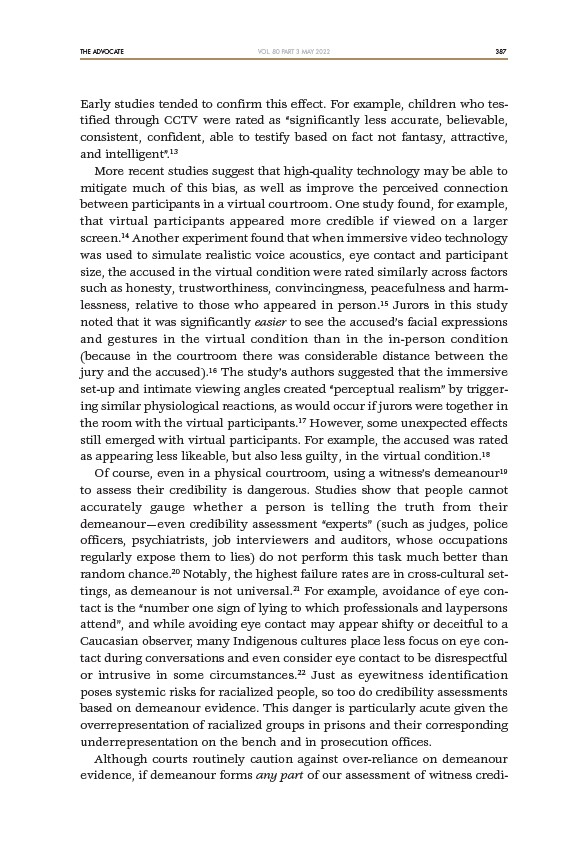
THE ADVOCATE 387
VOL. 80 PART 3 MAY 2022
Early studies tended to confirm this effect. For example, children who testified
through CCTV were rated as “significantly less accurate, believable,
consistent, confident, able to testify based on fact not fantasy, attractive,
and intelligent”.13
More recent studies suggest that high-quality technology may be able to
mitigate much of this bias, as well as improve the perceived connection
between participants in a virtual courtroom. One study found, for example,
that virtual participants appeared more credible if viewed on a larger
screen.14 Another experiment found that when immersive video technology
was used to simulate realistic voice acoustics, eye contact and participant
size, the accused in the virtual condition were rated similarly across factors
such as honesty, trustworthiness, convincingness, peacefulness and harmlessness,
relative to those who appeared in person.15 Jurors in this study
noted that it was significantly easier to see the accused’s facial expressions
and gestures in the virtual condition than in the in-person condition
(because in the courtroom there was considerable distance between the
jury and the accused).16 The study’s authors suggested that the immersive
set-up and intimate viewing angles created “perceptual realism” by triggering
similar physiological reactions, as would occur if jurors were together in
the room with the virtual participants.17 However, some unexpected effects
still emerged with virtual participants. For example, the accused was rated
as appearing less likeable, but also less guilty, in the virtual condition.18
Of course, even in a physical courtroom, using a witness’s demeanour19
to assess their credibility is dangerous. Studies show that people cannot
accurately gauge whether a person is telling the truth from their
demeanour—even credibility assessment “experts” (such as judges, police
officers, psychiatrists, job interviewers and auditors, whose occupations
regularly expose them to lies) do not perform this task much better than
random chance.20 Notably, the highest failure rates are in cross-cultural settings,
as demeanour is not universal.21 For example, avoidance of eye contact
is the “number one sign of lying to which professionals and laypersons
attend”, and while avoiding eye contact may appear shifty or deceitful to a
Caucasian observer, many Indigenous cultures place less focus on eye contact
during conversations and even consider eye contact to be disrespectful
or intrusive in some circumstances.22 Just as eyewitness identification
poses systemic risks for racialized people, so too do credibility assessments
based on demeanour evidence. This danger is particularly acute given the
overrepresentation of racialized groups in prisons and their corresponding
underrepresentation on the bench and in prosecution offices.
Although courts routinely caution against over-reliance on demeanour
evidence, if demeanour forms any part of our assessment of witness credi-